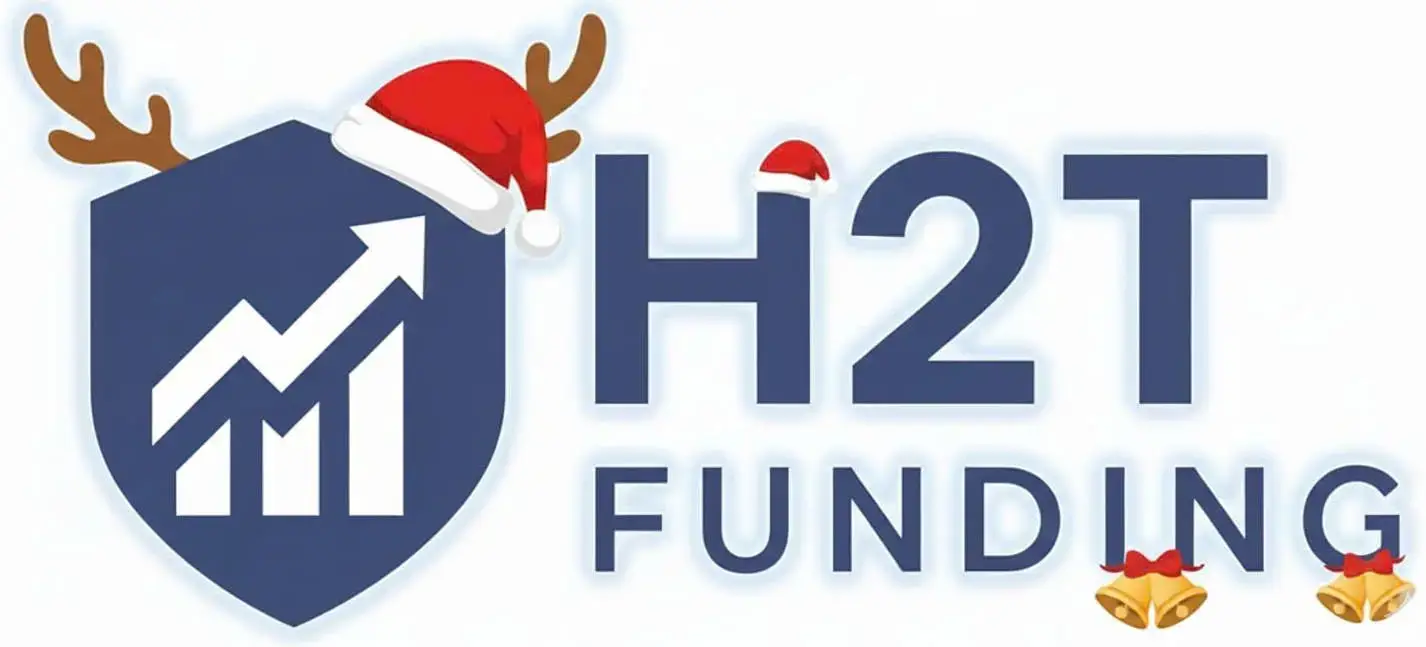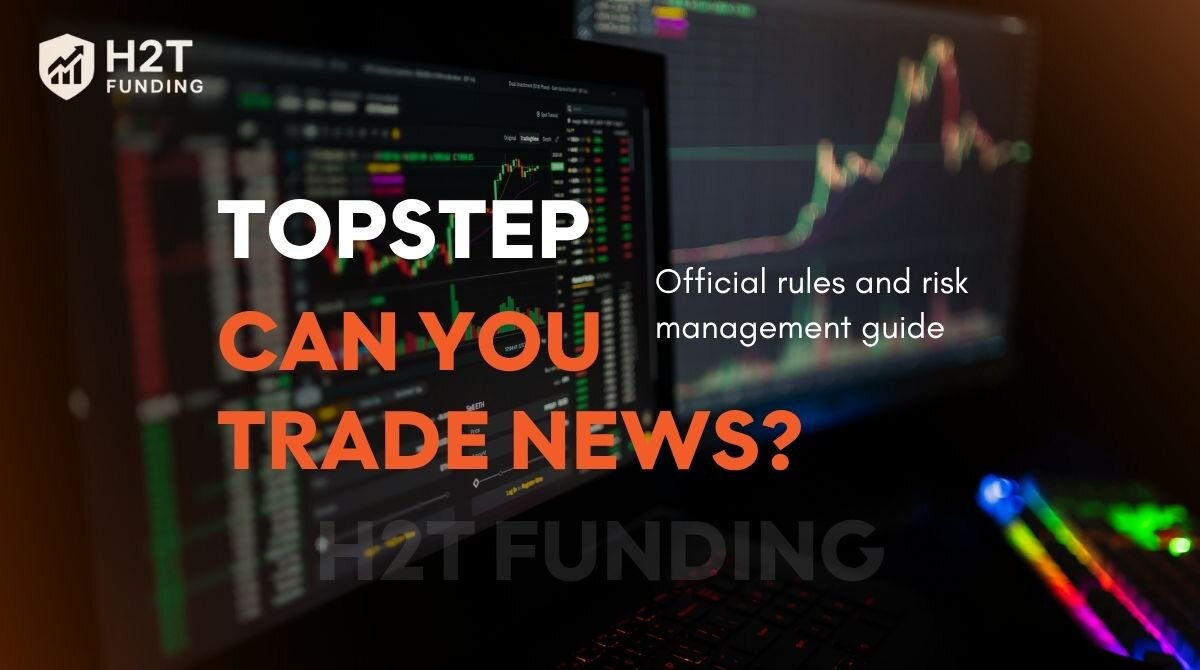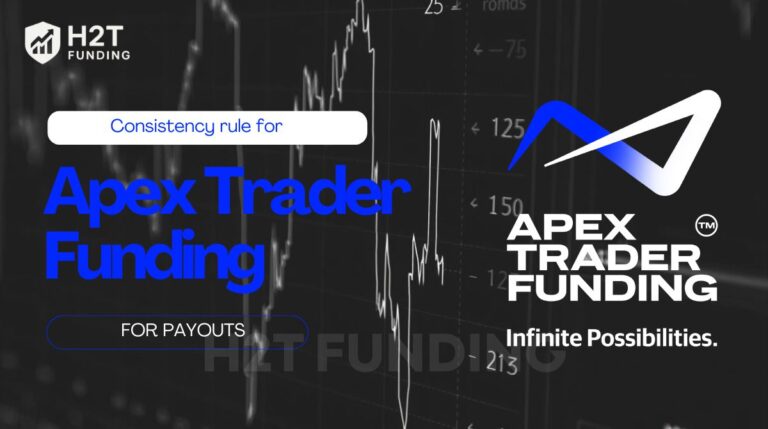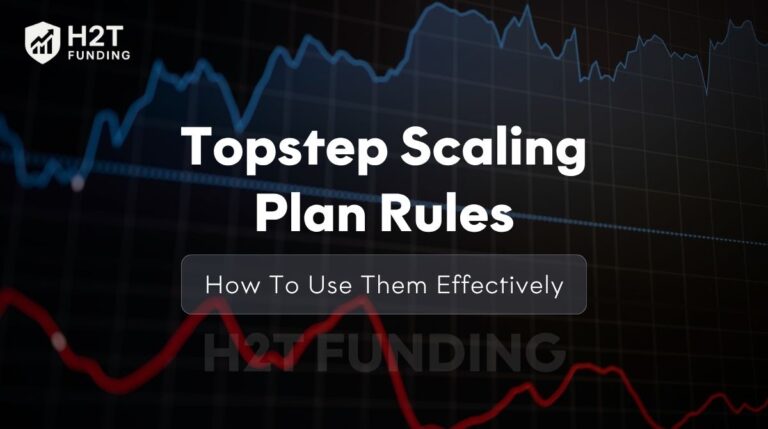Regarding the question, Topstep can you trade news?, the answer is far more nuanced than a simple “yes.” Unlike many prop firms that shut the door on news trading, Topstep opens that door, offering you the exciting freedom to engage with the market during major economic events. But with this freedom comes a heavy responsibility.
To truly succeed, you must go beyond just knowing the rules. You need to understand the hidden risks like slippage and grasp how strict loss limits are enforced. Embracing this challenge isn’t just about compliance; it’s about preparing yourself to navigate volatility with confidence and control.
In this article, H2T Funding will walk you through the official rules, spotlight hidden challenges like slippage and daily loss limits, and share tested strategies from experienced traders, helping you not just survive but confidently thrive amid market volatility.
Key takeaways
- Topstep allows news trading, but it comes with strict risk management rules and zero tolerance for breaches of daily loss limits.
- Trading during major economic events like NFP or FOMC releases exposes your account to extreme volatility, slippage, and widened spreads.
- Position sizing adjustment and waiting for volatility to settle before entering trades are critical strategies for managing risk effectively.
- The Topstep Trading Combine and Funded accounts have different stakes but share the same rules around risk and loss limits during news events.
- Success in news trading on Topstep depends on disciplined capital protection, understanding official policies, and mastering risk controls, not on guessing market direction.
1. So, Topstep can you trade news? The official answer
When it comes to news trading, Topstep shines by offering traders exceptional freedom compared to many proprietary firms. This freedom empowers you to seize opportunities while maintaining smart boundaries for your protection.
Mastering how Topstep handles economic releases and applies rules to Combine and Funded accounts is key to unlocking your full potential and trading with confidence.
Let’s start by exploring Topstep’s official stance.
1.1. Topstep’s official policy on news and economic releases
The official answer from Topstep can you trade news is clear: Yes, you can trade during news and economic releases. However, the firm makes it equally clear that this is at your own risk.
In practice, this means Topstep won’t restrict your trades during high-impact events like Non-Farm Payrolls (NFP), FOMC meetings, or CPI releases, but they also won’t protect you from the consequences.
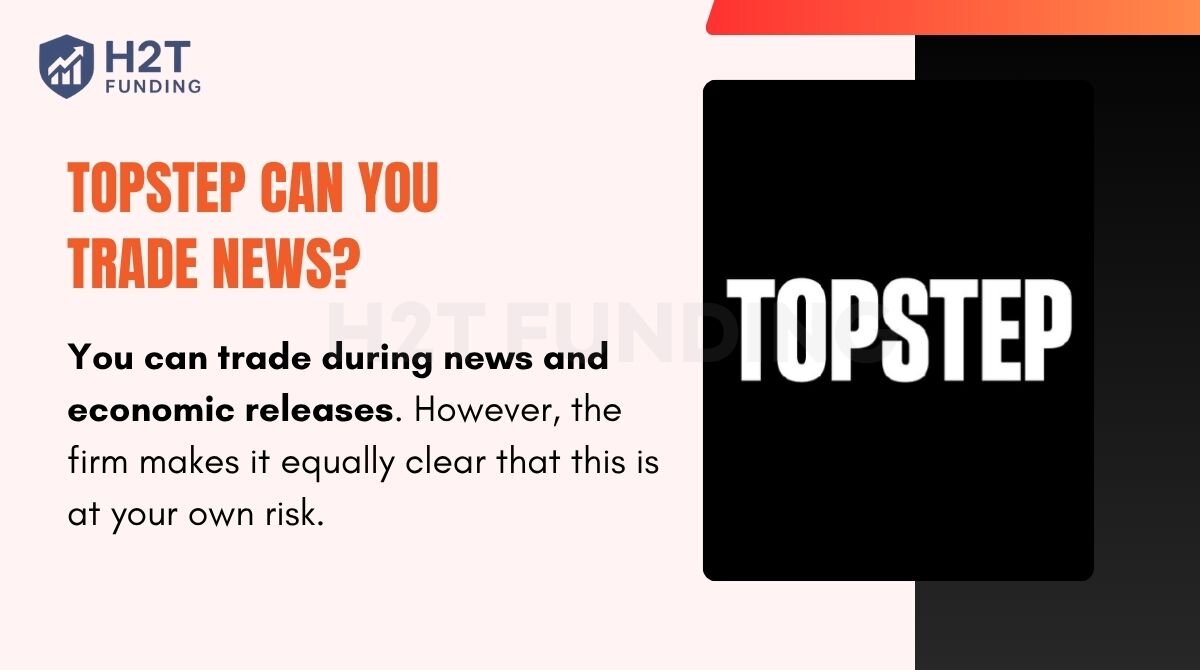
The phrase ‘at your own risk’ isn’t just a disclaimer; it’s an ironclad rule. This means Topstep will strictly enforce all core rules, especially the daily loss limit and trailing max drawdown, no matter how volatile the market gets.
If a price spike from news causes you to breach a rule, the system will automatically liquidate your positions and lock your account for the day. There are absolutely no exceptions, no refunds, and no reconsiderations. You are given full autonomy, and with it comes absolute accountability.
1.2. Different rules for Trading Combine vs. Funded accounts
In the Combine, your goal is to pass the evaluation. A mistimed trade can force you to restart, and yes, that is genuinely frustrating. However, each failure forces a review of your strategy, making you sharper for the next attempt.
On a Funded Account, you’re trading with real capital, which brings greater responsibility, but also greater reward. One wrong move can impact your profits or funded status, but it also challenges you to elevate your discipline and decision-making. This is your chance to prove yourself and build a sustainable trading career.
That’s why traders are encouraged to adopt even stronger discipline and focus once they’ve passed the evaluation. This isn’t just about protecting your account; it’s about making the transition to a true professional trader who can generate sustainable profits.
Read this article to find an appropriate prop firm: How to choose a prop firm in 2025
2. What are the limitations of Topstep?
While Topstep receives high marks for transparency, community support, and providing a realistic trading environment, there are several limitations that potential users should carefully consider before committing to the platform.
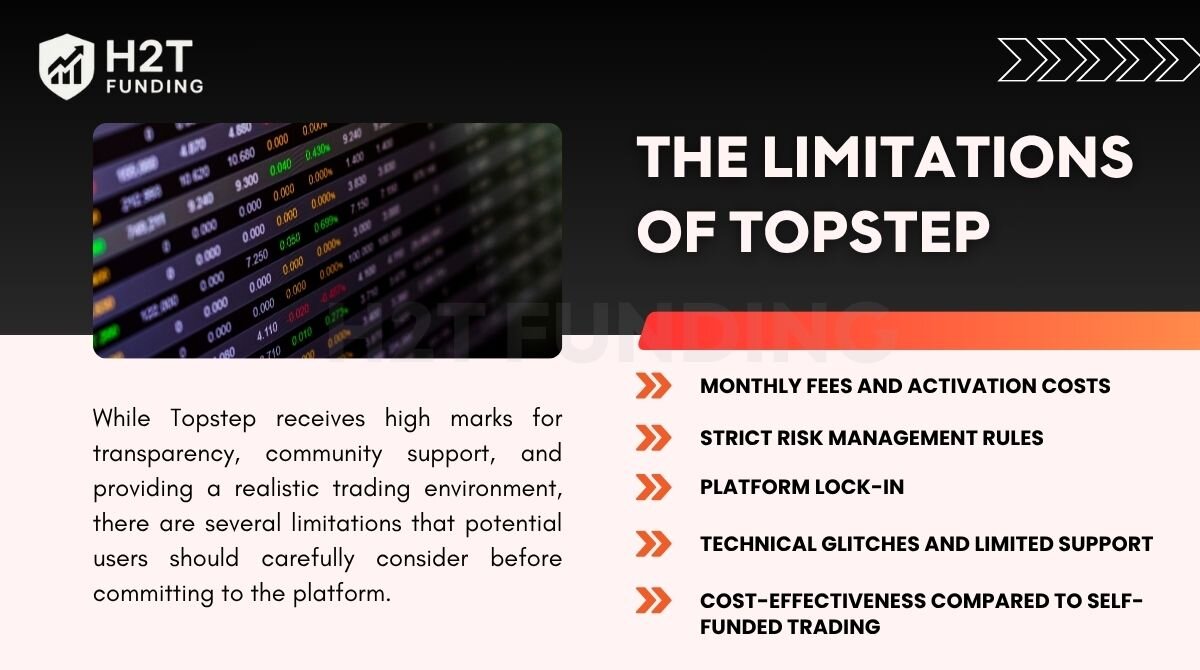
- Monthly fees and activation costs: Topstep requires an activation fee of $149, plus monthly subscription fees ranging from $49 to $149. For many traders, especially beginners or those without consistent profits, these recurring costs can quickly add up and become a significant financial burden over time.
- Strict risk management rules: The platform enforces tight daily and trailing drawdown limits, typically between 2% and 4%. This leaves very little margin for error and can increase psychological pressure, especially during volatile market conditions, leading to early disqualification.
- Platform lock-in: Traders must use the trading platform selected during their evaluation and cannot switch platforms without re-qualifying. This restricts flexibility for traders who may want to use tools better suited to their strategies or preferences.
- Technical glitches and limited support: Some users report occasional technical issues, particularly after Topstep discontinued phone support. The lack of direct, real-time support channels can negatively impact user experience and delay problem resolution.
- Cost-effectiveness compared to self-funded trading: For traders who are already profitable and have sufficient capital, paying monthly fees may be less economical than trading with their own funds independently, without the constraints imposed by Topstep’s structure.
From a practical standpoint, Topstep is best suited for disciplined traders seeking structured development, accountability, and strict risk control within a simulated live environment.
However, the combination of fees and tight risk parameters can be limiting, especially for experienced traders with their own capital. Therefore, deciding to use Topstep should involve a careful evaluation of one’s long-term growth goals against the costs and constraints imposed by the platform.
3. What are the primary risks of news trading on Topstep?
While allowed, trading news exposes your Topstep account to several significant risks that you must understand to survive. The following are the most common ways traders lose control fast when attempting to trade through major economic releases.
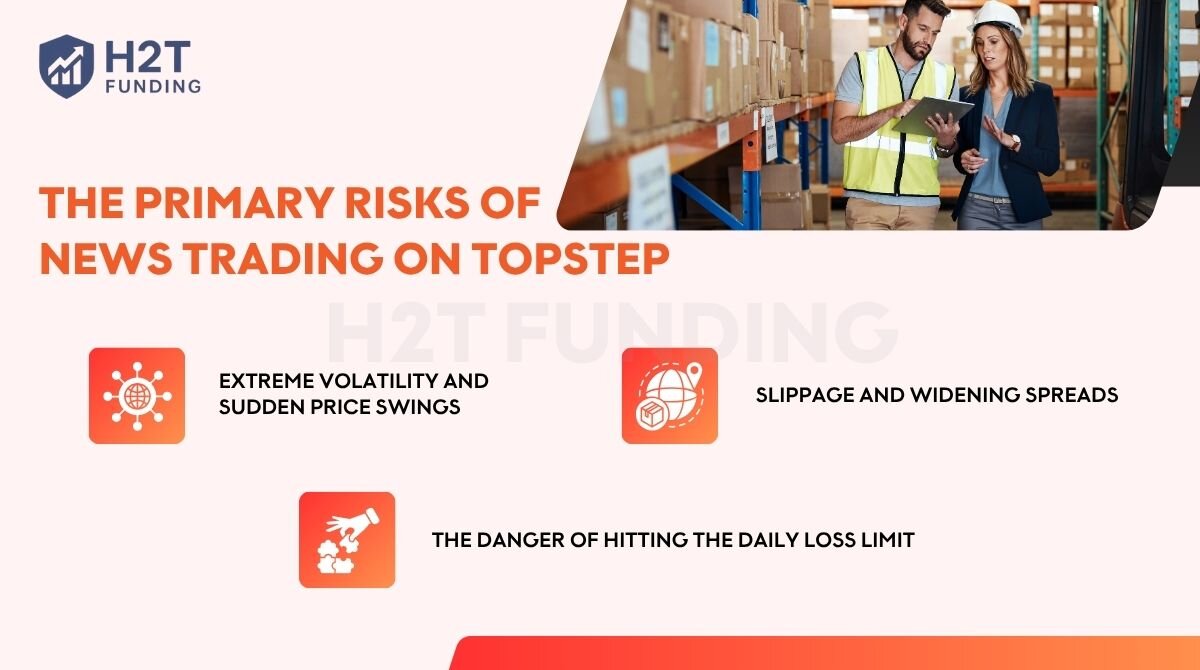
3.1. Extreme volatility and sudden price swings
Volatility refers to rapid, unpredictable price movements within a short period, often seconds or less. During economic news releases like Non-Farm Payrolls (NFP) or central bank announcements, volatility can surge dramatically.
Picture this: a candlestick that normally covers 3–5 ticks can suddenly spike 20–30 ticks or more in a single second. This sudden volatility isn’t a wave; it’s a tidal wave that can wipe out your stop-loss instantly.
Even professional traders get caught off guard during such moments. Without proper risk controls, a single candle can cost you your entire day’s risk allocation, especially on platforms like Topstep, where Daily Loss Limits are strictly enforced.
3.2. Slippage and widening spreads
High volatility rarely comes alone. It usually brings along two of a trader’s worst enemies: slippage and widening spreads.
- Widening spreads: The spread, the difference between the bid and ask prices, can increase dramatically around major news events. A typical 1-pip spread might suddenly expand to 5 or even 10 pips. This makes entries and exits far more expensive, eroding your profit potential or accelerating your losses.
- Slippage: Slippage occurs when your order is filled at a worse price than expected. For example, you might set a stop-loss at 4045.00, but due to fast-moving prices, it gets executed at 4042.50. This often results in instant, uncontrollable losses.
Combined, these factors can turn a seemingly safe trade into a costly mistake. Even a well-researched strategy can fall apart if you ignore the impact of slippage and spread widening during news events. What looks profitable in theory may become untradeable in real life.
3.3. The danger of hitting the daily loss limit
Topstep enforces a strict Daily Loss Limit across all accounts. Once this limit is breached, all open positions are closed automatically, and trading is disabled for the rest of the day.
Here’s the danger: Volatility plus slippage can compound rapidly. In the span of a few seconds, your trade can move from slightly red to fully violating your risk parameters, especially if you’re trading full size into a news event. And once you hit the Daily Loss Limit, there’s no appeal process; you’re done for the day, or worse, you may need to reset your Combine.
This is arguably the biggest risk in news trading on Topstep. Many accounts fail not because of bad setups, but because traders underestimate how quickly losses can escalate under extreme market conditions.
Explore more about Topstep rules:
4. Effective risk management for trading news on Topstep
Risks are unavoidable, but managing them effectively is the path to success. To trade news sustainably on Topstep, you need to apply practical, proven strategies that protect your capital and enable sound decision-making.
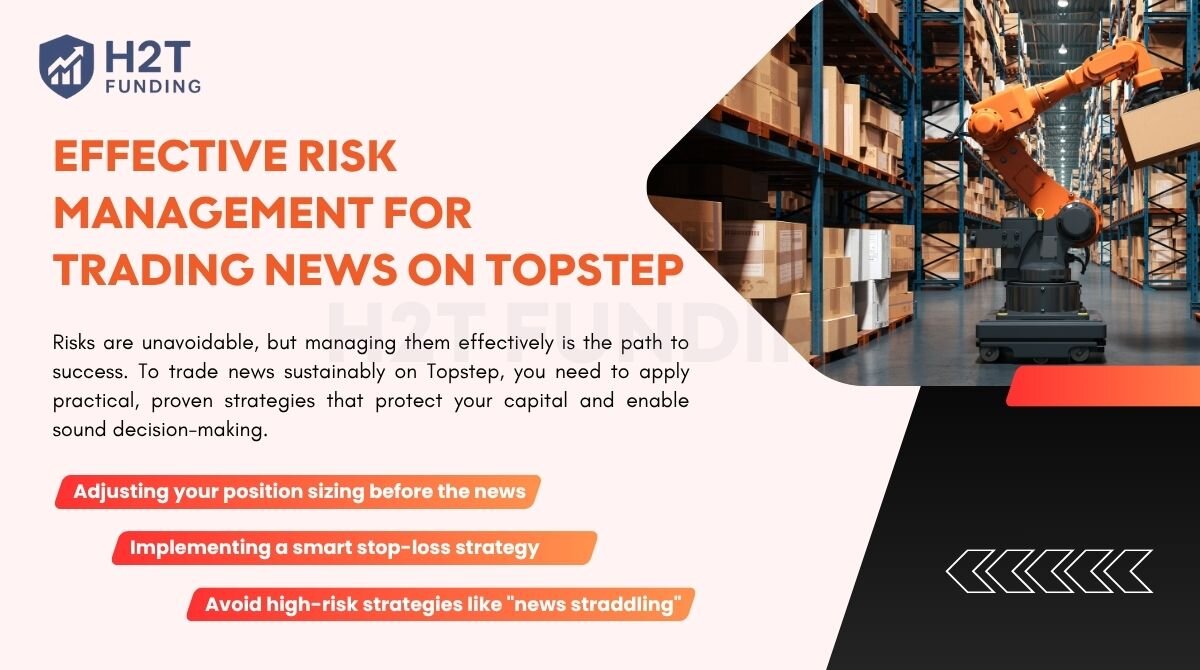
4.1. Adjusting your position sizing before the news
Adjusting your position sizing before major news isn’t just a strategy; it’s a mindset that separates successful traders from those who burn out quickly. Reducing your position size ahead of high-impact events is arguably the smartest defensive move you can make.
Instead of trying to predict the market’s every twist, the most experienced traders focus on managing risk and protecting their capital.
For example, if you usually trade 5 contracts, scaling down to 1 or 2, or even staying flat until the volatility settles, is not a sign of fear. It’s a sign of discipline and a commitment to longevity in this game.
My personal experience has shown that the most painful losses often happen when trying to trade full size right as news breaks. I’ve learned that surviving the storm of volatility is far more important than trying to catch every opportunity.
Topstep doesn’t limit position size before news, but remember: hitting your Daily Loss Limit will lock your account. Smaller positions mean you’re preserving capital to trade tomorrow, avoiding a knockout from a single sudden swing.
Furthermore, what is leverage in trading?
4.2. Implementing a smart stop-loss strategy
Placing a stop-loss during a news release requires nuance. A stop that’s too tight is almost guaranteed to get hit due to noise. A stop that’s too wide may expose you to damaging losses.
There is no one-size-fits-all stop-loss strategy for news trading, but a widely used approach among professionals is to wait 5–15 minutes after a major release before entering a position. This allows volatility to settle and market structure to form.
During the initial spike, spreads widen, slippage increases, and price direction is often misleading. Waiting helps you avoid false breakouts and lets you set a stop-loss based on confirmed structure, not chaos.
4.3. Avoid high-risk strategies like “news straddling”
News straddling refers to placing simultaneous buy stop and sell stop orders on either side of the current price just before a major release, aiming to catch the breakout, whichever way it goes.
While this may sound logical, it’s a high-risk, high-slippage strategy that often backfires on retail platforms.
Topstep does not prohibit this method, but it comes with serious execution risks. Spreads can widen so drastically that both orders get triggered, or the one that activates does so at a much worse price than expected. This often leads to instant drawdowns, not profits.
5. Frequently asked questions (FAQs)
Yes, you can hold positions during news releases. However, your account must still comply with the Daily Loss Limit and Trailing Max Drawdown. Sudden volatility may breach these rules even if you’re not actively trading.
Yes, the same rules apply in the Topstep Evaluation (Trading Combine) as in a Funded Account. It’s a good environment to test your reactions to news, but mistakes can cost you the challenge.
There is no official rule called the “Topstep combine news rule.” This phrase usually refers to standard rules (like loss limits and max drawdown) applied when trading news during the evaluation phase.
Yes, most platforms used with Topstep accounts include a basic economic calendar. Still, traders are encouraged to use more detailed sources like Forex Factory or Investing.com for better preparation.
6. Conclusion
So, to conclude the question, Topstep can you trade news?, The answer is yes, but it’s a ‘yes’ with a major condition. Topstep gives you the freedom to engage with the market, but success doesn’t come from guessing the direction of the news.
It comes from disciplined protection of your capital against volatility, slippage, and the firm’s strict risk parameters. Mastering this is the key to not just surviving, but potentially thriving in the Topstep trading environment.
Before risking real capital, make sure to practice these strategies thoroughly on a demo account. For deeper insights and expert advice, explore the Prop Firm & Trading Strategies section at H2T Funding, your go-to resource for mastering trading with prop firms.
